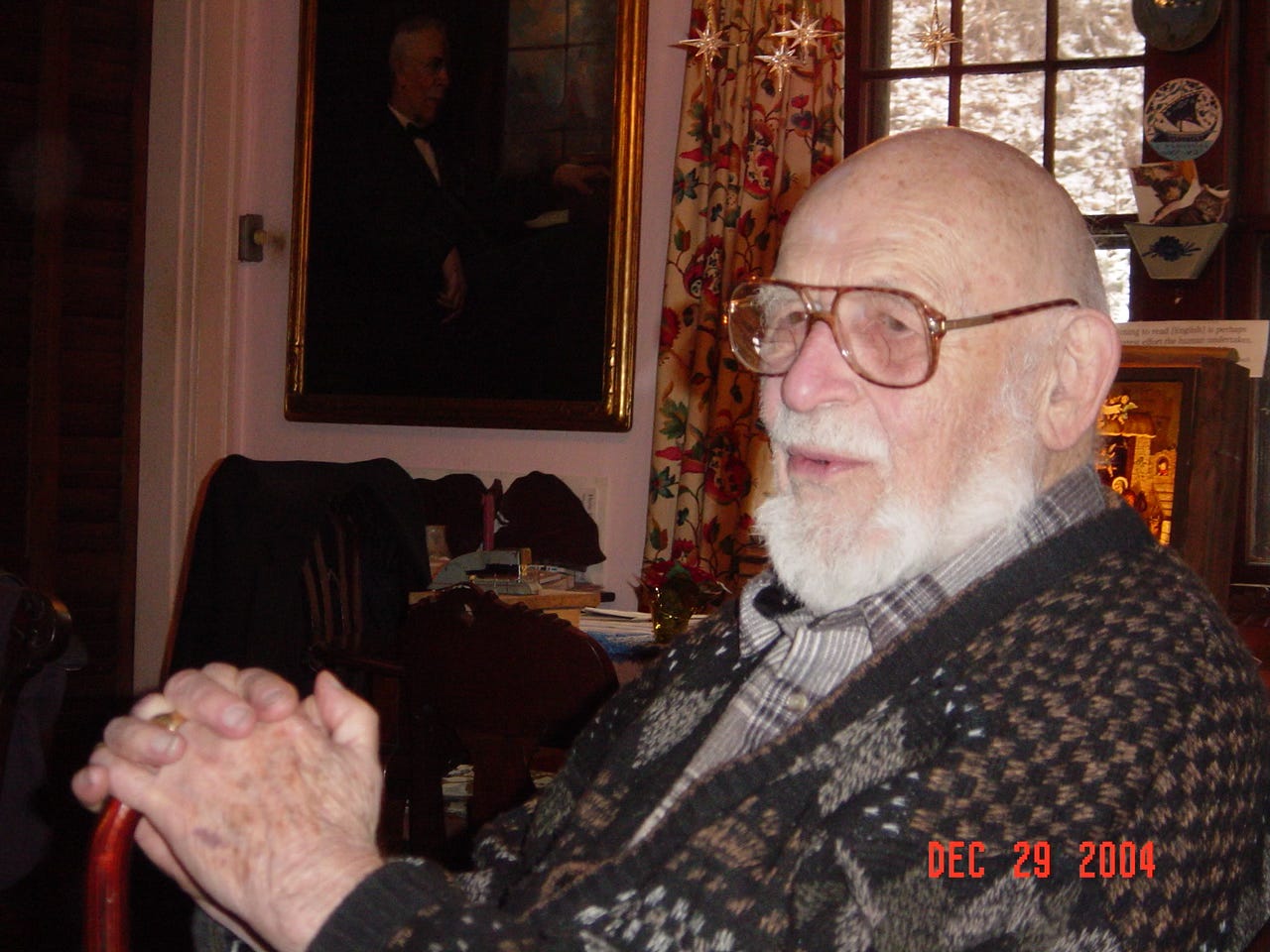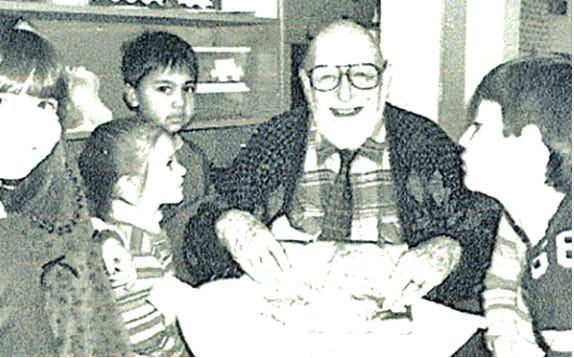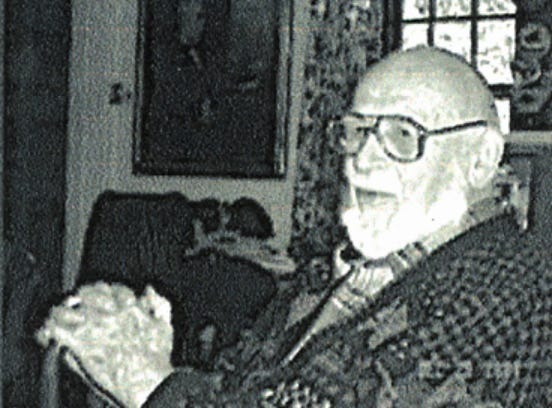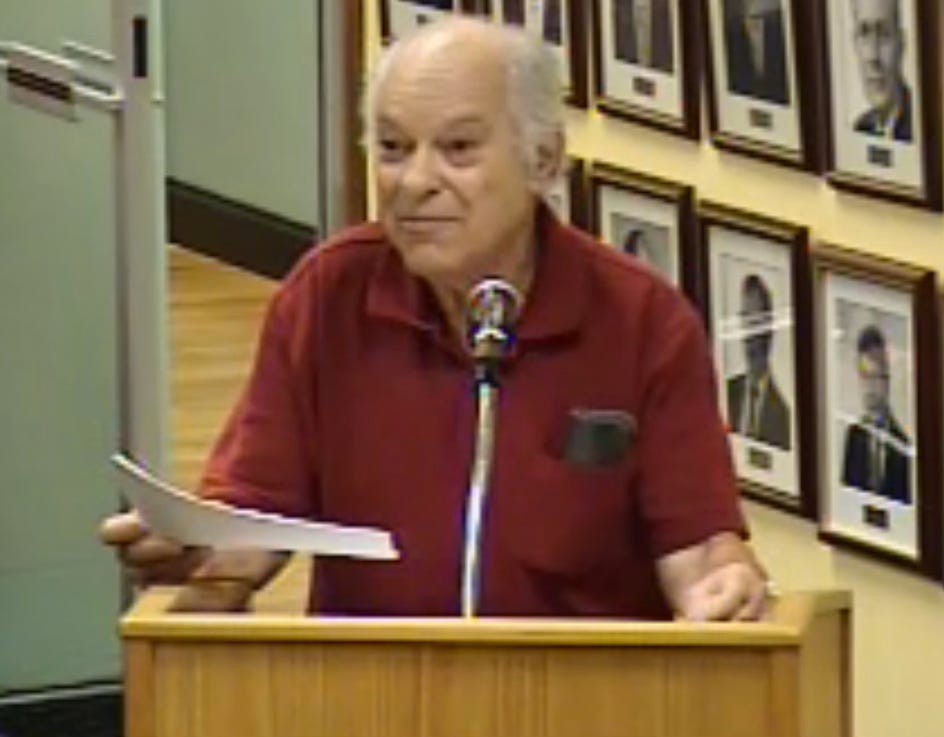Guest Essay: Ed Rondthaler, my neighbor.
"I recall as a child sitting with his three sons and other neighborhood kids at Ed’s feet as he spun one yarn after another; each more enthralling than its predecessor."
by Joel Gingold
Editor’s Note: Edward Rondthaler, who died in 2009 at age 104, was a typographer and passionate advocate of simplified spelling. He lived in Croton for many decades. Rondthaler was a Nordica Drive neighbor of long-time Croton resident Joel Gingold, who featured an essay about him in his book “The Street Where I Live and Other Essays.”
On May 18, Croton’s famous “Picture Tunnel” will be dedicated to Rondthaler’s memory (see announcement at the bottom of this essay.) Gingold kindly gave us permission to reproduce his essay here. Gingold supplied a new introduction to the piece, which we include here as well:
“One of Ed’s great loves in Croton, was the view looking out across the Hudson River from what he dubbed the ”Picture Tunnel,” since it framed the river view as if it were a portrait. Though now strictly a pedestrian path, for many years, the one-lane road through the Picture Tunnel carried all traffic under the railroad tracks into Senasqua Park, giving thousands of visitors to the park that view of the river that Ed so cherished. Recently, the Village of Croton and its HEART Committee decided to dedicate the Picture Tunnel to Ed’s memory.”
Of all of those chronicled in this [chapter], it was Ed Rondthaler that I knew best. I first met Ed in the 1940s as a child of about eight and went all through school with his middle son, David. Later, I was privileged to be his and his wife, Dorothy’s, neighbor on Nordica Drive for several decades, almost to the day he passed away at the age of 104!
Ed was born in 1905 in Bethlehem, Pennsylvania, the son and grandson of Moravian bishops. But he grew up in Winston-Salem, North Carolina, where his father served as president of Salem College. And it was North Carolina that Ed brought with him to Croton in the early 1940s. A dedicated Tar Heel (he graduated from the University of North Carolina, Chapel Hill) Ed never lost his mellifluous Carolina drawl despite spending the last sixty-plus years of his life in Croton.
To the outside world, Ed was renowned as a pioneer in photo-typesetting, which revolutionized printing and freed printers from centuries of “hot metal” type. In the mid-1930s, he and a colleague, Harold Horman, perfected a phototypesetting device that helped streamline the traditional art of setting type. The process let type be shrunk, enlarged, stretched, and squeezed without casting a single drop of metal. He later was co-founder of organizations that designed and licensed, in his words, “alphabets” (we would now call them fonts) for publishers of all stripes.
But most of Ed’s friends and neighbors, myself included, were unaware of his distinguished stature in the printing world. He lived and acted modestly at home and was a kind of surrogate uncle or grandfather to many.
A student of letters and words, he spent decades trying to impose order on his twenty-six lawless charges. One of Ed’s great passions was his crusade for phonetic spelling of English. Recognizing that there was little logic or consistency to English spelling and that this hindered many in learning the language and retarded literacy, he campaigned for years to make the changes he felt were essential. “Foenetic speling wil maek reeding and rieting neerly automatic for evrybody,” Ed wrote in SoundSpel, a simplified English spelling system he had refined from an earlier model.
But alas, he never achieved success in this effort, and consequently, this essay is written with what some delusional being decided centuries ago was proper English spelling, with all of its notable and aggravating inconsistencies.
And Ed was a storyteller. He exhorted parents to not just read to their children, but to tell them their own self-created stories. I recall as a child sitting with his three sons and other neighborhood kids at Ed’s feet as he spun one yarn after another; each more enthralling than its predecessor.
But Ed not only expressed himself verbally. He was the author of a number of books dealing principally with alphabets and letter design. Almost every week, our local paper featured a letter to the editor penned by, as one neighbor dubbed him, “The Sage of Nordica Drive.” And the subjects of these missives could range from local political issues, to “foenetic speling,” to whatever else may have been on Ed’s mind that week. He wrote a song honoring the hundredth anniversary of the Croton Dam, and he devised a number of useful contraptions, including a slide rule that calculated currency-exchange rates and a similar device that computed cooking times of foods based on their weight.
Having grown up in the Moravian Church, Ed used to take great delight in telling any who would listen that Jan Hus, the great fifteenth-century religious reformer of Prague, preceded Martin Luther by more than a century. And this despite Ed’s decades-long active membership in our local Lutheran congregation. So I was extremely gratified when, during one of my many visits to the Czech capital, I could acquire for Ed some souvenirs from the reconstructed Jan Hus church and from the museum that was Hus’s nearby home.
Before his retirement, Ed’s offices were in New York City. Every morning, he would walk the mile-and-a-quarter from his home, up and down the intervening hills, to the Croton-Harmon station to catch the commuter train to the city, and reverse the process each evening. I don’t know if he ever calculated exactly how many thousands of miles he trod over the decades, but perhaps that contributed to his longevity. I made the same journey for more than twenty years, but I never came close to erasing Ed’s record, one that I expect will stand forever.
Along with all of his other activities, Ed still found time to participate actively in the official life of the community. He was involved in a myriad of village committees supporting recreation and other village services. He was also an authority on local history and especially that surrounding the Croton River, which flowed through the gorge directly across the street from his home. When the History of Croton-on-Hudson was published to commemorate the bicentennial of the American Revolution, the article on the Croton River was, of course, authored by Ed Rondthaler.
At times, if you passed Ed’s home when he was sitting on his porch, or otherwise encountered him around the village, he would buttonhole you and regale you for hours, if you’d let him, with his stories and anecdotes, historical and otherwise. On occasion, he would invite you into his home and describe at length the wire sculpture of the Croton River, complete with bridges, dams, and unique buildings, that adorned his living room wall. There were some of these tales that I was convinced were, shall we say, grossly exaggerated, only to find out later that Ed’s accounts were one-hundred-percent accurate.
Age never seemed to slow Ed down. He drove his car well past his century mark, and even wrote an article on how he had gleefully defied his children when they attempted to extract his car keys from his grasp.
One January afternoon my wife, Jeanette, and I were walking past Ed’s house when we saw him up on a ladder removing Christmas decorations from the ceiling of his porch. Fearing for his safety, we ran over and offered to complete the job for him. But we were sternly rebuffed. Ed declared that we did not know how to do the job properly and he would not even acquiesce to our holding the ladder while he was aloft. And a little while later, he scrambled down without a hitch and packed away the ornaments for another year.
For his hundredth birthday, the community gathered for a tribute at the Croton Free Library. And after all of the accolades and presentations, Ed rose slowly to his feet and entertained the assembled throng with about forty-five minutes of stand-up, regaling us with his memories, his stories, and, of course, taking a significant chunk of the time to advocate for his theories on “foenetic speling.”
Once he officially became a centenarian, Ed launched a whole new career as the star of a number of television commercials. He became a spokesman for Genworth Financial, Pearle Vision, and House Industries, among others, and was interviewed by CNN. One day, when our neighborhood was inundated by a crew filming one of these spots, I passed Ed’s ancient mailbox, across the street from his home. Over the years, it had become embedded in a tree that had grown around it. A young technician was busy touching up the mailbox. “Painting Ed’s mailbox?” I asked. “Yes,” he replied. “We want it to look old, but not that old.”
But eventually Ed’s health began to fail—although not his intellect or his enthusiasm—and in 2008 he moved to Cedar City, Utah, to be near his son Tim. Stories trickled back that Ed had completely taken over the senior living center where he took up residence. But sadly, he passed from us on August 19, 2009.
Unfortunately, Ed left Nordica Drive shortly before we began our tradition of annual block parties. But he has attended every one of them in spirit and there has not been a single such occasion when at least one or two of those of us in attendance did not recount stories of Ed Rondthaler and the enormous influence he had on us all.
Joel Gingold has been a resident of Croton for more than 80 years. He wrote two books about his life in Croton and elsewhere, “Now Hear This” and “On the Street Where I Live.”
*********************************************************************************************************
“PICTURE TUNNEL” DEDICATION CEREMONY
Date: Sunday, May 18 Time: 2:00 PM – 2:45 PM
Location: Gather at the Picture Tunnel *All Welcome*
Join the HEART committee for a special commemoration ceremony & plaque dedication honoring longtime Croton resident, Ed Rondthaler. This event, celebrates Ed's lasting contributions to the community and preserves his legacy for future generations.
Sponsored by The Village of Croton HEART Committee
********************************************************************************************************
To share this post, or to share The Croton Chronicle, please click on these links.








Joel, I didn’t know Ed personally but your memoir brought him very much to life. I walk through the picture tunnel every week.
I remember looking so forward to seeing Ed's comments in the Gazette. You are right about his sense of independence. One day I was delivering him Meals on Wheels and he said he had to get his recycles out and I told him I would help. He said no need as he had devised a way to put wheels on the bottom of the bins and was so proud to show me how it all worked. What a remarkable gentleman!